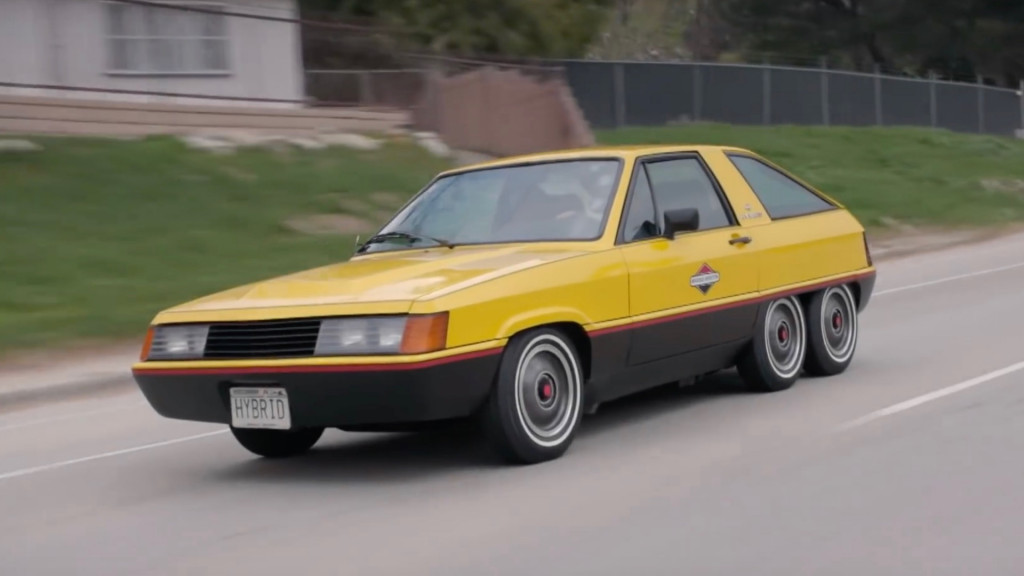Long before the Toyota Prius and the GM EV1 were conceived, a U.S. company not otherwise known for making cars showed a most unusual vehicle possibly described as a progenitor of plug-in hybrids.
The company was Briggs & Stratton. And the car, first shown on the heels of the 1979 oil crisis and simply called the Hybrid, had six wheels.
The Hybrid is certainly no cobweb-covered barn find. It was on exhibit at the former Powerhouse Museum in Milwaukee. But Jay Leno’s Garage recently convinced Briggs & Stratton to take it out on the road for the first time since 1988.

1980 Briggs & Stratton Hybrid Jay Leno's Garage screenshot
Leno talked to Craig Claerbout, an engineering technician at the company, to discuss some of the tech details in the Hybrid, along with why it exists. Claerbout did some technical work on the vehicle when they were still making it and bringing it around to shows.
Briggs & Stratton is best known for making the single-cylinder internal-combustion engines that powered decades of American lawnmowers, riding mowers, and other power equipment like generators—and in twin-cylinder form, some larger tractors.
In the late 1970s, as the U.S. emerged from one energy crisis to another—with the shock of gas prices breaking past a dollar a gallon in 1979—Briggs & Stratton surely wasn’t the first company with a hybrid or hybrid concept. But it wanted to show that with the supplement of an electric-motor system a very modest gasoline engine was enough for cruising at the then-national 55-mph speed limit and potentially higher.
The Hybrid was actually quite advanced—and sophisticated looking—for its time. The vehicle has a parallel drive system, allowing the driver to manually select whether the vehicle is physically powered by the gasoline engine, the electric motor, or both. It could go up to 60 miles, fully electric, at 40 mph or less in EV mode, with nearly 1,000 pounds of lead-acid batteries and an 8-hp electric motor.

Briggs & Stratton Hybrid - tech
Those batteries were carried independently by the rearmost axle, while the axle ahead of that acted as the drive axle and the rear axle for the rest of the car.
The engine bay was split between the electric motor and a little 18-horsepower, 694-cc 2-cylinder air-cooled engine—with a clutch allowing either source to be engaged with the 4-speed manual transmission. That, the clutch, the front suspension, and the steering were borrowed from the Ford Pinto while the doors, dash, and windshield were borrowed from the Volkswagen Scirocco, with much of the rest of the car built with original sheetmetal, all on a tubular frame.
The car runs on 72 volts, with a dozen 6-volt lead-acid batteries in the hatch—so cargo space would have been an issue. While the Hybrid can’t charge the battery pack with the internal combustion engine, and charging was via a 110-volt AC socket, a later update of the Hybrid Concept did add regenerative braking.

Briggs & Stratton Hybrid
In the video, Claerbout says that it’s good for about 30 mpg—which was still a lot better than most sporty coupes of the time. The top speed is 68 mph—a feat for a vehicle running on 18 hp and weighing 3,200 pounds.
In 2013, BBC reported that the original pitch behind the Hybrid was breaking down the “performance-based barriers to customer acceptance of an electric car as primary personal car.”
While those barriers seem to have been blasted past with some of the newest electric cars like the Porsche Taycan or, for that matter, the Tesla Model 3, other barriers exist that might still have seemed inconsequential back then—the lack of charging infrastructure, and the price of the batteries themselves, for instance.
Watch the video below for a good look at what this fully functioning oddity from the past is like to drive today.
In truth, the concept car probably earns a lot more respect today than it did 40 years ago, and it’s a good bookmark for Briggs & Stratton to look back on as they’re among many internal-combustion-focused companies aiming to stay relevant by going electric.













